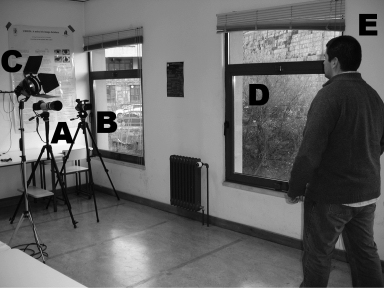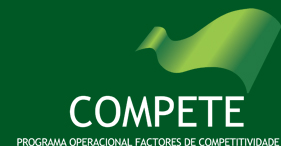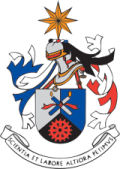|
Departamento
de Informaica da Universidade da Beira Interior |
|
Contact: SOCIA Lab.: Soft Computing and Image
Analysis Group Department of
Computer Science, University of Beira Interior,
6201-001 Covilha, Portugal |
UBIRIS.v2 In 2004 we released
the UBIRIS.v1 database. Our purpose was to simulate
less constrained imaging processes and acquire
visible wavelength images with several types of data
occluding the iris rings (considered noise). A large
number of experiments were conducted on this
database and reported in the literature, although
the realism of its noise factors received some
criticisms. This was a major motivation for the
development of a new version of the database
(UBIRIS.v2) in which the images were actually
captured on non-constrained conditions
(at-a-distance, on-the-move and on the visible
wavelength), with corresponding more realistic noise
factors.
Fig1. Overview of the
used image acquisition framework (A,B), light
sources (C,D) and subjects location (E). The major purpose of
the UBIRIS.v2 database is to constitute a new tool
to evaluate the feasibility of visible wavelength
iris recognition under far from ideal imaging
conditions. In this scope, the various types of
non-ideal images, imaging distances, subject
perspectives and lighting conditions existent on
this database could be of strong utility in the
specification of the visible wavelength iris
recognition feasibility and constraints.
The setup of the
imaging framework is given in the above table. As
illustrated in figure 1, this framework was
installed on a lounge under both natural and
artificial lighting sources. We placed several marks
on the floor (between three and ten meters away from
the acquisition device) and asked for volunteers for
the image acquisition processes. Two distinct image
acquisition sessions were performed, each one during
two weeks and separated by an interval of one week.
From the first to the second session the location
and orientation of the acquisition device and
artificial light sources was changed, in order to
increase heterogeneity. Volunteers were at large
majority latin caucasian (around 90%) and also black
(8%) and asian people (2%). Around 60% of the
volunteers performed both imaging sessions, while
40% performed exclusively one, either during the
first or second acquisition period. Subjects were
required to walk at a slightly slower than normal
speed and to look at several lateral marks that
obliged them to rotate head and eyes, enabling the
manual capturing of 3 images per meter, between
eight and four meters, giving a total of 15 images
per eye and session, for the large majority of the
individuals. It should be stressed that this
requested cooperative behavior had the unique
purpose of normalizing the number of usable images
per subject and imaging session. A completely covert
procedure could have been used with a necessarily
lower number of usable images per session. As it is
illustrated in figure 2, the significantly higher
range of distances between the subjects and the
imaging framework is one of the major
distinguishable points between the UBIRIS.v2
database and the remaining ones. Download
Application Form: [pdf] All requests for the
UBIRIS.v2 database must be directed (by email) to
the following address: hugomcp@di.ubi.pt. Applicants
should manually fill, sign, scan and
attach the application form to the given
email address. Upon receipt of an executed copy of
the signed application form, access instructions
will be given. Download Password
Protected ZIP Files: [zip1] [zip2] [readme] Citation: All documents and
papers that report on research that uses the
UBIRIS.v2 database must database by including an
appropriate citation: "Hugo
Proença, Sílvio Filipe, Ricardo Santos, João
Oliveira, Luís A.
Alexandre; The UBIRIS.v2: A Database of Visible
Wavelength Iris Images
Captured On-The-Move and At-A-Distance, IEEE
Transactions on Pattern
Analysis and Machine Intelligence, August, 2010,
volume 32, number 8,
pag. 1529-1535, ISSN: 0162-8828, Digital Object
Identifier
http://doi.ieeecomputersociety.org/10.1109/TPAMI.2009.66".
@article{pro09a ,author = "Proenca,
H. and Filipe, S. and Santos, R. and
Oliveira, J. and Alexandre,{L.A.}" ,title = "The
{UBIRIS.v2}: A Database of Visible Wavelength
Images Captured On-The-Move and At-A-Distance" ,journal = "IEEE
Trans. PAMI" ,volume = "32" ,doi =
{10.1109/TPAMI.2009.66} ,number = "8" ,pages =
"1529-1535" ,month = "August" ,year = "2010" } Publications to
SOCIA Lab.: A copy of all reports
and papers that use the UBIRIS.v2 database and are
for public or general release must be forwarded
immediately upon release or publication to the SOCIA
Lab. email address: socia@di.ubi.pt |
|
|
||||||||||||||||||||||||||||
fghfghfghfgh
DI-UBI Bloco VI Rua Marques de Avila e Bolama P-
6201-001
Covilha, PORTUGAL







